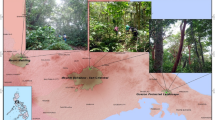Abstract
Eighteen species of eleven lichen genera were found on driftwood and worked timber deposited on the beaches in the Hornsund and Billefjorden regions (the west coast of Spitsbergen, Svalbard archipelago). Majority of them indicate low substrate specificity in the high arctic regions. Only three species (Caloplaca spitsbergensis, Lecanora mughicola, L. orae-frigidae) are typical for lignum. Most of the taxa are widespread in Svalbard. Species like: Caloplaca holocarpa, C. spitsbergensis, Protothelenella sphinctrinoidella, Rinodina archaea were sporadically reported till now. Lecanora mughicola was not reported from Svalbard up to the present and this is the first record of the species for the region.
Similar content being viewed by others
References
Alstrup V. 1977. Cryptogams on imported timber in West Greenland. Lichenologist 9: 113–117.
Alstrup V. 1982. The epiphylic lichens in Greenland. Bryologist 85(1): 64–73.
Brodo I.M. & Vänskä H. 1984. Notes on the maritime, lignicolous lichen Lecanora orae-frigidae. Lichenologist 16(1): 45–51.
Chochorowski J. 1999. Problems of the dendrochronology of Russian hunting stations of Spitsbergen. Oficyna Cracovia, Kraków, 104 pp.
Eggertsson Ó. 1994. Driftwood as an indicator of relative changes in the influx Arctic and Atlantic water into the coastal areas of Svalbard. Polar Research 13(2): 209–218.
Elix J.A., Wardlaw J.H. & Søchting U. 2000. Anthraquinones from the lichen Caloplaca spitsbergensis. Herzogia 14: 27–30.
Elvebakk A. 1997. Tundra diversity and ecological characteristics of Svalbard, pp. 347–359. In: Wielgolaski F.E. (ed.), Polar and alpine tundra, Elsevier.
Elvebakk A. & Hertel H. 1996. Part 6. Lichens, pp. 271–359. In: Elvebakk A. & Prestrud P. (eds), A catalogue of Svalbard plants, fungi, algae and cyanobacteria, Norsk Polarinstitutt Skrifter 198.
Hafellner J. 1982. Flechtenfunde am Bockfjord, Spitzbergen. Ergebnisse der österreichischen Spitzbergen-Expedition 1979, I. Phyton 22: 23–50.
Hertel H. 1977. Bemerkenswerte Flachtenfunde aus dem Gebiet des Kongsfjordes und des Isfjordes (Spitzbergen). Herzogia 4: 367–401.
Hertel H. & Ullrich H. 1976. Flechten von Amterdamøya (Svalbard). Mitt. Bot. Staatssammal. München 12: 417–512.
Himelbrant D. & Kuznetsova E. 2002. Lignicolous lichens on driftwood of the Keret’ archipelago (White Sea). Botanica Lithuanica 8(4): 349–355.
Johansen S. 1999. Origin of driftwood in north Norway and its relevance for transport routes of drift ice and pollution to the Barents Sea. Sci. Total Environ. 231(2–3): 201–225.
Lynge B. 1926. Lichens from Bear Island (Bjørnøya) collected by Norwegian and Swedish expeditions, chiefly by Th. M. Frties during the Swedish polar expedition of 1868. Result. Norske Statsunderst. Spitsbergeneksp. 1(9): 1–78.
Magnusson A.H. 1944. Studies in the ferruginea-group of the genus Caloplaca. K. Vet. Vitt.-Samh. Handl. Sjätte Följden, Ser. B 3(1): 1–71.
Orange A., James P. W. & White F. J. 2001. Microchemical methods for identification of lichens. British Lichen Society, London, 101 pp.
Palka K. & Śliwa L. 2004. Lichen species new to Mongolia. Polish Bot. J. 49(1): 35–43.
Printzen C. 2001. Corticolous and lignicolous species of Lecanora (Lecanoraceae, Lecanorales) with usnic or isousnic acid in the Sonoran desert region. Bryologist 104(3): 382–409.
Santesson R., Moberg R., Nordin A., Tønsberg T. & Vitikainen O. 2004. Lichen-forming and lichenicolous fungi of Fennoscandia. Museum of Evolution, Uppsala University, Uppsala, 359 pp.
Søchting U. 1989. Lignicolous species of the lichen genus Caloplaca from Svalbard. Opera Bot. 100: 241–257.
Søchting U. 2001. Chemosyndromes with chlorinated anthraquinones in the lichen genus Caloplaca, pp. 395–404. In: McCarthy P.M., Kantvilas G. & Louwhoff S.H.J.J. (eds), Lichenological Contributions in Honour of Jack Elix, Bibliotheca Lichenologica 78.
Søchting U. & Olech M. 1995. The lichen genus Caloplaca in polar regions. Lichenologist 27: 463–471.
Śliwa L. & Wetmore C. 2000. Notes on the Lecanora varia Group in North America. Bryologist 103(3): 475–492.
Thomson J.W. 1997. American Arctic Lichens. The Microlichens. The University of Wisconsin Press, Wisconsin, 736 pp.
White F.J. & James P.W. 1985. A new guide to microchemical techniques for the identification of lichen substances. Briti. Lich. Soc. Bull. 57(Suppl.): 1–41.
Žurbenko M.P. & Vekhov N.V. 2001. Lišajniki na obnažennoj drevesine postroek arkhipelaga Novaja Zemlja i ostrova Vajgač. Novosti Sistematiki Nizšikh Rastenij 34: 126–134.
Author information
Authors and Affiliations
Corresponding author
Rights and permissions
About this article
Cite this article
Osyczka, P., Węgrzyn, M. Lichens on lignum in the coastal regions of western Spitsbergen (Svalbard). Biologia 63, 1069–1072 (2008). https://doi.org/10.2478/s11756-008-0158-0
Received:
Accepted:
Published:
Issue Date:
DOI: https://doi.org/10.2478/s11756-008-0158-0




